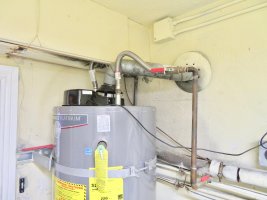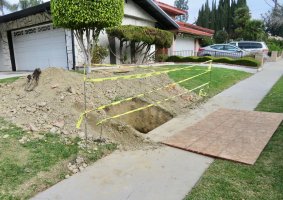-
Welcome to The Building Code Forum
Your premier resource for building code knowledge.
This forum remains free to the public thanks to the generous support of our Sawhorse Members and Corporate Sponsors. Their contributions help keep this community thriving and accessible.
Want enhanced access to expert discussions and exclusive features? Learn more about the benefits here.
Ready to upgrade? Log in and upgrade now.
You are using an out of date browser. It may not display this or other websites correctly.
You should upgrade or use an alternative browser.
You should upgrade or use an alternative browser.
An average day
- Thread starter ICE
- Start date
fatboy
Administrator
Oh my....The house is vacant. The new owner was there for inspection of a PV system and an electrical service upgrade. The water heater has corrections and no permit. I had to tell her to not use it.. She wanted me to explain why the real estate "home" inspector didn't mention the water heater deficiencies.
View attachment 3772
steveray
SAWHORSE
That's one of those new "powerCOpoisoningvent" setups?
jar546
CBO
High tensile strength caution tape?
A solar contractor....gosh I hate calling them contractors....I think I'll change it up and call them Solar Entrepreneurs. This SE has a C-10 license so they are allowed to install electric service upgrades. That happened on this job.
I found this at the first inspection:
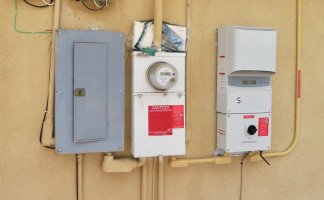
I wrote a correction that stated that the SE can't add any power to this arrangement and Edison will be be told that they can't continue to supply power either. That resulted in a permit to upgrade the service panel. Edison spotted the meter about 50' from the original and that required a meter main with a sub-panel at the original location.
I have been there six times for inspection as the SE stumbled through the forest of codes getting to the last set of corrections. There is a spacious attic and you can see a cable that is a feeder from the main to the sub-panel.
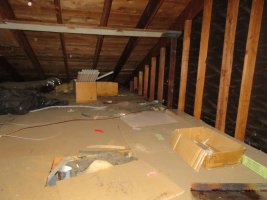
The next picture shows where the cable enters a conduit. It pokes through the wall and drops four feet to a panel cabinet. The sheath was removed before it entered the enclosure.
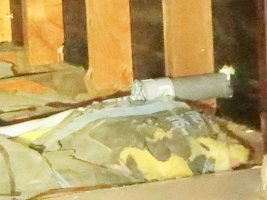
The cable disappears beyond duct work and the same violation is repeated at the other end.
On the way it put a load on a duct.
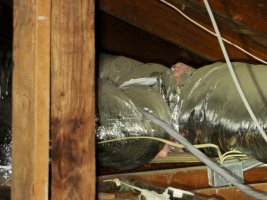
This sixth visit was the first time that I had access to the inside of the dwelling. The house is vacant and now I met the new owner. The water heater from post 3048 was also found here. I could tell that she was feeling betrayed by the realtors and previous owners....even the inspector that she hired.
The attic is accessed by a pull down stair. She pulled it down. It made an awful noise as the mechanism malfunctioned. Long steel parts bent and twisted. She assumed that this was how it was supposed to operate and forced it to the floor. I was not in the hallway when she did it so I didn't mention the incident. There will be no closing that stair.
This being trip six I was somewhat dismayed with the SE's "chief electrical employee". I have explained all of the defects in detail at five inspections to five not the chief electrical employees.. This time the correction says "NMC is not allowed in a wet location". The SE's CEE asked me what NMC means. I just shook my head and said that the clue is in the wet location part of the correction.
The thing that any of the uninformed public should take away from seeing this is not that it happened. No....the thing to realize is that this happens on a regular basis. This type of work is typical. Did you get that Maam....I said typical and worse. Spend some time in this thread. Look at the dates. It is almost daily. That's because I find this stuff every day that I work. Now ask yourself, what are the odds that the work done on my solar was any different?
Scary huh! Ohhhh! the horror of shoddy work. Fear not hapless homeowner, for the systems aren't failing and burning down the house. Thousands of these outcomes go unnoticed by inspectors but there seems to be no consequence. By the time that the physical degradation of solar components could become dangerous, the panels will be weakened such that they won’t produce enough electricity to matter.
The elephants in the room are the solar manufacturers. From panels to the racking, the least amount of everything has been sought out.
The metal is aluminum. It is exposed to the elements and the Sun. Take a close look at a twenty year old Winnebago that spent it's existence in the desert.
Aluminum expands and contracts and all of the parts rely on an intimate connection to achieve an electrical bond. The installation instructions point out that fact with specific torque values for each bit of hardware. Every nut, bolt and screw. Nobody pays attention to that......they never use a torque wrench or driver. They do not have any.
C-taps are used everywhere they can. C-taps should be banned. I pull them off with one hand.
Numbers 8 and 6 bare copper wire is used to bond panels and racking here and there. The bare copper is in direct contact with aluminum components such as panel frames. It will take a few years for the copper to melt it's way into the panel but it will happen. When it does there may not be enough current flow due to poor bonding to trip a breaker. It might wait for a person to complete a circuit.
In twenty years there will be a new genera of Solar Entrepeneur They will be in the business of removing PV and safe disposal. They will be busy.
I found this at the first inspection:

I wrote a correction that stated that the SE can't add any power to this arrangement and Edison will be be told that they can't continue to supply power either. That resulted in a permit to upgrade the service panel. Edison spotted the meter about 50' from the original and that required a meter main with a sub-panel at the original location.
I have been there six times for inspection as the SE stumbled through the forest of codes getting to the last set of corrections. There is a spacious attic and you can see a cable that is a feeder from the main to the sub-panel.

The next picture shows where the cable enters a conduit. It pokes through the wall and drops four feet to a panel cabinet. The sheath was removed before it entered the enclosure.

The cable disappears beyond duct work and the same violation is repeated at the other end.
On the way it put a load on a duct.

This sixth visit was the first time that I had access to the inside of the dwelling. The house is vacant and now I met the new owner. The water heater from post 3048 was also found here. I could tell that she was feeling betrayed by the realtors and previous owners....even the inspector that she hired.
The attic is accessed by a pull down stair. She pulled it down. It made an awful noise as the mechanism malfunctioned. Long steel parts bent and twisted. She assumed that this was how it was supposed to operate and forced it to the floor. I was not in the hallway when she did it so I didn't mention the incident. There will be no closing that stair.
This being trip six I was somewhat dismayed with the SE's "chief electrical employee". I have explained all of the defects in detail at five inspections to five not the chief electrical employees.. This time the correction says "NMC is not allowed in a wet location". The SE's CEE asked me what NMC means. I just shook my head and said that the clue is in the wet location part of the correction.
The thing that any of the uninformed public should take away from seeing this is not that it happened. No....the thing to realize is that this happens on a regular basis. This type of work is typical. Did you get that Maam....I said typical and worse. Spend some time in this thread. Look at the dates. It is almost daily. That's because I find this stuff every day that I work. Now ask yourself, what are the odds that the work done on my solar was any different?
Scary huh! Ohhhh! the horror of shoddy work. Fear not hapless homeowner, for the systems aren't failing and burning down the house. Thousands of these outcomes go unnoticed by inspectors but there seems to be no consequence. By the time that the physical degradation of solar components could become dangerous, the panels will be weakened such that they won’t produce enough electricity to matter.
The elephants in the room are the solar manufacturers. From panels to the racking, the least amount of everything has been sought out.
The metal is aluminum. It is exposed to the elements and the Sun. Take a close look at a twenty year old Winnebago that spent it's existence in the desert.
Aluminum expands and contracts and all of the parts rely on an intimate connection to achieve an electrical bond. The installation instructions point out that fact with specific torque values for each bit of hardware. Every nut, bolt and screw. Nobody pays attention to that......they never use a torque wrench or driver. They do not have any.
C-taps are used everywhere they can. C-taps should be banned. I pull them off with one hand.
Numbers 8 and 6 bare copper wire is used to bond panels and racking here and there. The bare copper is in direct contact with aluminum components such as panel frames. It will take a few years for the copper to melt it's way into the panel but it will happen. When it does there may not be enough current flow due to poor bonding to trip a breaker. It might wait for a person to complete a circuit.
In twenty years there will be a new genera of Solar Entrepeneur They will be in the business of removing PV and safe disposal. They will be busy.
Last edited:
jar546
CBO
Do you inspect in Bangladesh? Sure looks like it.
TheCommish
SAWHORSE
I can fix, where is my roll of aluminum tape?
Mech
REGISTERED
Those Safe-T-Switches and blue wire nut look familiar. Is that the same furnace from post #3037?
Yes it is the same furnace...and I must say that I am surprised that you remembered the first picture. People can do some amazing things.Those Safe-T-Switches and blue wire nut look familiar. Is that the same furnace from post #3037?
At the initial inspection I wrote a correction asking for a single wall to B vent adapter. It looked like B vent was sticking out of the ceiling and naturally a single wall vent would not be legitimate concealed in a wall. However, a closer look at the picture has me wondering if the vent at the ceiling is B vent after all.
I am going to contact the company and suggest that they have someone present for the next inspection so we can get to the bottom of this.
Here is what I am talking about. Obviously it is the original venting but it just seems wrong enough to get it corrected.
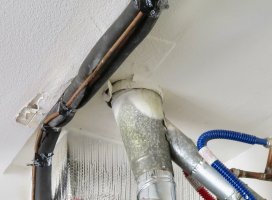
Straps across a ridge are not unusual.
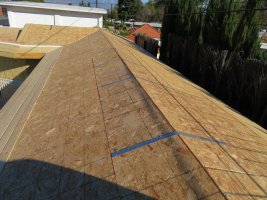
https://flic.kr/p/Si6pyu
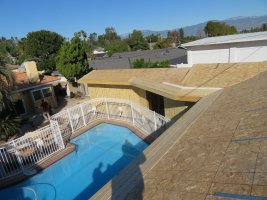
I have never encountered MST48 straps across a ridge....that's what the plans specified.
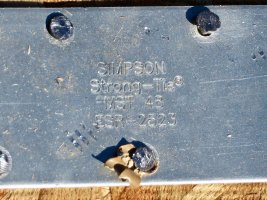
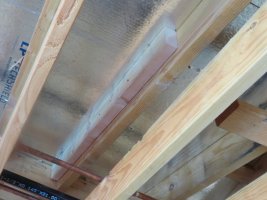

https://flic.kr/p/Si6pyu

I have never encountered MST48 straps across a ridge....that's what the plans specified.


They may be required per 802.3.1 given certain methods of traditional stick framing. Also see Figure R802.5.1.Straps across a ridge are not unusual.
The tiles were removed on the plane of roof that has PV. Rolled roofing has been applied. The pv has been installed and the tiles around the perimeter have been placed. There’s no tiles under the array. This is a common approach to mounting PV.
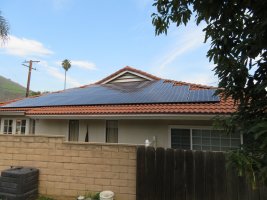
The bird stop has been left in place. The bird stop has small weep holes. That's because tile roofs might get some moisture under the tiles. Some moisture is way different than a flow which is what can be expected with the new setup. Eventually all of the flow will find a way out.....that is unless the weep holes get plugged with trash, junk and debris. Even as an open weep hole, a few hours of steady rain will overburden the weep holes and water might do what water does.
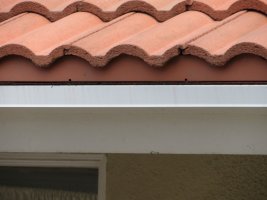
I have mentioned this to several solar companies but they continue....I'm pretty sure they know something that I don't.

The bird stop has been left in place. The bird stop has small weep holes. That's because tile roofs might get some moisture under the tiles. Some moisture is way different than a flow which is what can be expected with the new setup. Eventually all of the flow will find a way out.....that is unless the weep holes get plugged with trash, junk and debris. Even as an open weep hole, a few hours of steady rain will overburden the weep holes and water might do what water does.

I have mentioned this to several solar companies but they continue....I'm pretty sure they know something that I don't.
Last edited:
steveray
SAWHORSE
The tiles were removed on the plane of roof that has PV. Rolled roofing has been applied. The pv has been installed and the tiles around the perimeter have been placed. There’s no tiles under the array. This is a common approach to mounting PV.
WHAT?.....They don't waterproof the roof for the sake of PV? I don't imagine there is a good waterproofing transition detail from roll roof to tile....
What's the purpose of the strap across the ridge? It would be nice if
the nails were properly set before installing the shingles.
I would think the tile to roll roofing would be ok, if the tile laps far enough ovef the start of the roll material. On the down hill side, one would hope the roll material goes all the way to the drip edge, and the tiles are just decoration. Probably not. The bird stop on the bottom ... you suppose they added some at the new intermediate tile openings? Just kidding.
Well I reckon that strap keeps the rafters held against the ridge board. Maybe it gives the roof diaphragm a bit more omf. I really don't know exactly. The roof covering will be tile so they won't show through and the usual strap is an ST 24 which is smaller than an MST48.Whats the purpose of the strap across the ridge? It would be nice if the nails were oroperly set before installing the shingles.
The building is small.....hardly big enough to have bothered...it’s not more than eight feet wide with a strong wall at the gable end. So that MST strap almost seemed okay.
Mighty small or is it small but mighty. It’s a two bed, two bath ADU. The main house is seven bedrooms with six bathrooms. This is in a 70s tract of 2000 sq ft homes. The owner can’t understand why the neighbors are upset.
Last edited:
Well I reckon that strap keeps the rafters held against the ridge board. Maybe it gives the roof diaphragm a bit more omf. I really don't know exactly. The roof covering will be tile so they won't show through and the usual strap is an ST 24 which is smaller than an MST48.
The building is small.....hardly big enough to have bothered...it’s not more than eight feet wide with a strong wall at the gable end. So that MST strap almost seemed okay.
Mighty small or is it small but mighty. It’s a two bed, two bath ADU. The main house is seven bedrooms with six bathrooms. This is in a 70s tract of 2000 sq ft homes. The owner can’t understand why the neighbors are upset.
They may be required per 802.3.1 given certain methods of traditional stick framing. Also see Figure R802.5.1.

